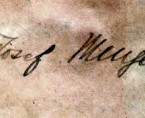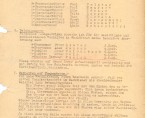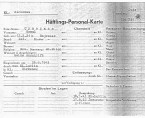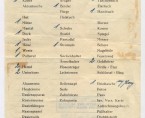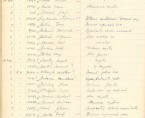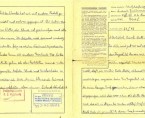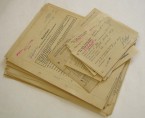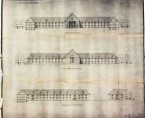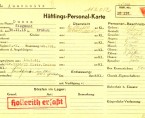Collection
The collection held in the Archives of the Auschwitz-Birkenau State Museum can be divided into several parts:
- original documents created by camp offices while Auschwitz was in operation
- original documents created by Auschwitz prisoners outside the official camp bureaucratic structure (camp resistance movement material)
- copies of documents related to Auschwitz, obtained from other institutions
- postwar source material (trial records, accounts and memoirs by former prisoners)
- a collection of illustrations
- an audio-visual collection
The documents held in the Archives were discovered for the most part on the grounds of the liberated camp or in places where they were clandestinely sent while the camp was operating. The Archives have obtained additional documents from former prisoners, their families, and various industrial facilities where there were Auschwitz sub-camps.
The original documents held in the Archives represent only a part of the records produced in the camp offices during the war. As the front line approached, the Nazis hurriedly attempted to destroy as many documents as possible or to carry them away into the depths of the Reich, in order to remove evidence of the crimes committed in the camp. After liberation, the Red Army confiscated some of the records that the Germans had not managed to destroy, and shipped them to the former USSR. Some of those documents are preserved to this day in archives there.
CAMP CHANCELLERY RECORDS
The six departments that made up the camp administrative system produced original documents during the time when Auschwitz Concentration Camp was in operation, from the spring of 1940 to January 1945. These departments were:
Department I – the office of the camp commandant
Department II – political
Department III – camp director
Department IIIa – prisoner labor
Department IV – administrative-economic
Department V – camp hospitals
In their offices, these departments created documents characteristic of their tasks.
Documents created in Department I (the office of the camp commandant) are related to overall matters connected with the SS garrison posted to Auschwitz. Examples of these records in the archives include:
- personnel files on some SS personnel from the Auschwitz camp garrison
- a collection of the camp commandant’s orders from 1941-1944
- telegrams about escapes of prisoners from Auschwitz
- telegrams notifying next of kin about the deaths of prisoners in the camp
- the log of remarks by the duty officer (Führer vom Dienst) with entries from May 18, 1941 to March 2, 1943
Documents from Department II (political department) are connected mainly with personal records on prisoners incarcerated in Auschwitz and the typical police functions of the department, including the punishment of prisoners. Especially noteworthy are:
- lists of the names of prisoners newly arrived in Auschwitz
- prisoner personal files
- prisoner death certificates
- disciplinary reports, with requests for the punishment of prisoners
Department III (camp director) exercised administrative and disciplinary functions in regard to the prisoners. Noteworthy documents from this section include:
- the record book of the camp for Roma in Auschwitz II-Birkenau
- the daily prisoner count book
- the block no. 11 bunker record book
- prisoner block record books for blocks no. 4 and 16 in Auschwitz I and block no. 22 in the camp for female prisoners in KL Auschwitz II-Birkenau
- the record book of the penal company
- files of deceased Soviet prisoners of war
Department IIIa dealt with all matters connected with labor assignments for the prisoners in the camp. The most important documents from this department include:
- correspondence among the Auschwitz labor department, various Third Reich administrative organs, and other Nazi concentration camps on matters connected with prisoner labor
- personal card files on prisoners kept by the labor department (the Museum holds only copies of documents obtained from archives in Moscow)
- lists of bonuses for prisoners assigned to specific labor details
- lists of labor assignments for male and female prisoners
- card files on prisoners employed in the camp as electricians and metalworkers/machinists
Department IV (administrative-economic) dealt with general matters connected with supplies of food and clothing for both SS personnel and Auschwitz prisoners. The documents connected with the functioning of this department include:
- the supply of fuel needed in the crematorium
- passes for trips by trucks sent from Auschwitz to various places (including the plant in Dessau that produced Zyklon-B gas);
- card files on the outfitting and equipment of SS personnel in the camp garrison
- correspondence with next of kin of deceased prisoners concerning belongings left on deposit in the camp
Department V was responsible for health care for the SS camp garrison. Medical care for prisoners was limited to rudimentary medical facilities commonly referred to as “hospitals.” Typical documents for this department included:
- record books for the camp hospitals, of which there are extant fragments for blocks no. 20, 21, and 28 at Auschwitz
- reports from the camp hospital on the deaths of prisoners
- the record books of the camp X-ray station
- lists of the camp numbers of deceased prisoners
- reports on the removal of gold dental work from corpses of deceased prisoners
- various records from the camp hospitals in Auschwitz II-Birkenau
- the record books of the prisoner hospital from Auschwitz III-Monowitz Concentration Camp in Monowice
- card files with medical records of prisoners
- a record book of deceased Soviet POWs
PRISONER CORRESPONDENCE
A collection of camp correspondence by prisoners represents a separate section of the original documentation. These are camp letters and camp postcards sent through official channels from Auschwitz prisoners to their relatives in the outside world. For this official correspondence, prisoners were required to use special forms that they purchased at the camp commissary. Since they were subject to censorship by the camp administration, the letters and postcards sent by prisoners were required to be written in German. Jewish prisoners, like Soviet POWs, were denied the possibility of corresponding with their families.
SS HYGIENE INSTITUTE RECORDS
The archival collection also includes documentation connected with the SS and Police Hygiene Institute in Oświęcim (Hygiene Institut der Waffen-SS und Polizei Auschwitz O/S). Founded in the fall of 1942 as a branch of the SS Main Hygiene Bureau, it was subordinated to the SS Main Sanitary Bureau (SS-Hauptsanitäramt) in Berlin. It was based in the Auschwitz I Main Camp until the spring of 1943, when it was transferred to Rajsko, where it functioned until evacuation in January 1945.
The Hygiene Institute performed all hygienic and bacteriological laboratory work for local SS, Wehrmacht, and police units, as well as for concentration camps (the entire Auschwitz-Birkenau complex including the sub-camps, and also Gross-Rosen Concentration Camp). The Institute analyzed samples of blood and other bodily fluids collected from camp prisoners, the SS garrison troops and their families, and armed SS and Wehrmacht formations stationed in the Oświęcim area. The analysis was mainly intended to detect cases of typhus, malaria, and syphilis. Prisoners assigned to kommandos (labor details) providing services to the Auschwitz SS garrison (in the SS kitchens and clothing and equipment stores) were subject to frequent testing. The SS Hygiene Institute had the following laboratories: bacteriological, chemical, biological, histological, serological, Wassermann, and climatological, as well as a laboratory in block no. 20 in the Auschwitz I camp and a section that produced growth media for bacteria cultures. Each of these units kept its own records, some of which survived and are now held in the Museum Archives.
The principal parts of the SS Hygiene Institute collection are:
- the main record books (Hauptbüchern) – 9 volumes
- the subsidiary record books (Nebenbüchern) – 8 volumes
- orders for various kinds of tests on blood and other fluid samples, and the results – 62 volumes
SS ZENTRALBAULEITUNG RECORDS
The Archives of the Auschwitz-Birkenau State Museum in Oświęcim also hold documents created by theSS Central Construction Board in Oświęcim (Zentralbauleitung der Waffen-SS und Polizei Auschwitz O/S). The Central Construction Board kept records on all building work at the Auschwitz-Birkenau camp complex. The most important items in this collection are:
- plans for the Auschwitz I and Auschwitz II-Birkenau camps
- plans, technical documentation, and cost estimates for various construction projects at Auschwitz-Birkenau Concentration Camp (including the plans for the gas chambers and crematoria at Auschwitz II-Birkenau Concentration Camp)
CAMP RESISTANCE MOVEMENT MATERIALS
Material connected with the camp resistance movement constitutes a separate part of the original documentation held in the archives. Noteworthy items include:
- periodic reports about the situation in the camp sent through clandestine channels from Auschwitz to the local resistance movement outside the camp
- secret messages smuggled out of the camp by prisoners
- lists of deceased women prisoners compiled illegally in the camp by prisoner Antonina Piątkowska on the basis of information in the camp hospital record books
TRIAL RECORDS
The trial records held in our archives illustrate the ways in which Nazi war criminals were brought to justice. The majority of these materials are not originals. The most significant include:
- material from the trial of Rudolf Höss, the founder and first commandant of Auschwitz
- material from the trial of 40 other members of the Auschwitz garrison who, like Höss, were tried before the Polish Supreme National Tribunal
Both of these sets of documents include the indictments, testimony by former prisoners called as witnesses, explanatory statements by the accused, copies of original camp documents entered into the proceedings by the prosecution, and the verdicts and sentences.
COPIES OF TRANSPORT LISTS
While the majority of the documents in the archives concern registered Auschwitz prisoners, it should be noted that, thanks to cooperation with various institutions of a similar nature throughout the world, the archives have also been enriched by copies of transport lists of people deported to Auschwitz from various places where they were previously concentrated. This applies mostly to the deportation of Jews. These records include:
- transport lists of Jews deported to Auschwitz from the camp in Drancy near Paris
- transport lists of Jews deported to Auschwitz from the camp in Westerbork in the Netherlands
- transport lists of Jews deported to Auschwitz from the camp at the ghetto-city of Theresienstadt (Terezin) near Prague
- transport lists of Jews deported by the Gestapo to Auschwitz from Berlin
MATERIAL ON OTHER CONCENTRATION CAMPS
A separate part of the archival holdings is made up of material on other Nazi concentration camps. In this case, as well, most of the items are copies. They include:
- lists of prisoners sent from Dachau to Auschwitz and lists of prisoners transferred from Auschwitz to Dachau;
- lists of prisoners transferred from Auschwitz to Buchenwald
- lists of prisoners transferred from Auschwitz to Flossenbürg
- lists of prisoners transferred from Auschwitz to Gross-Rosen
- lists of prisoners transferred from Auschwitz to Stutthof
- lists of prisoners transferred from Auschwitz to Dachau
- lists of prisoners transferred from Auschwitz to Ravensbrück
- lists of prisoners transferred from Auschwitz to Mauthausen
In the case of Mauthausen, it should be noted that the original personal file cards on the prisoners were saved after liberation thanks to the efforts of Polish prisoners, including former Auschwitz prisoners. These files are now in our archives. Since these cards accompanied prisoners when they were transferred from one Nazi concentration camp to another, many of the cards in the Mauthausen file were originally issued in Auschwitz.
RECORDS FROM THE SUB-CAMPS
Various records associated with the functioning of some of the Auschwitz sub-camps make up a separate part of the archival holdings. It should be noted that the completeness of these records varies greatly among the different sub-camps. In relative terms, the greatest numbers of original documents are extant from the Jawischowitz sub-camp in Jawiszowice and the Janinagrube sub-camp in Libiąż. Our archival holdings include documents related to the following Auschwitz sub-camps:
- Blechhammer in Sławęcice nesr Blachownia Śląska
- Charlottegrube in Rydułtowy
- Chelmek in Chełmek
- Eintrachthütte in Świętochłowice
- Fürstengrube in Wesoła near Mysłowice
- Golleschau in Goleszów
- Günthergrube in Lędziny
- Janinagrube in Libiąż
- Jawischowitz in Brzeszcze-Jawiszowice
- Neu-Dachs in Jaworzno
- Trzebinia in Trzebionka
RECORDS FROM THE POSTWAR HOSPITALS
The archival collections also include original documents related to the functioning of the hospitals for liberated prisoners that the Polish Red Cross established on the grounds of the liberated camp and in Oświęcim and Brzezinka. Documents that illustrate this part of the history of the camp include:
- the so-called Bellert book (named for Dr. Józef Bellert of Cracow, the director), containing personal information on the liberated Auschwitz prisoners in the Polish Red Cross Hospital
- lists of liberated prisoners by nationality
